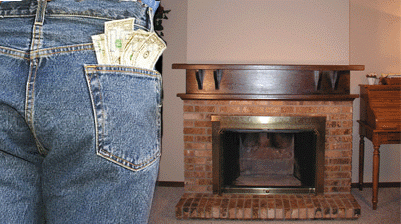Fireplaces take more than they give. On a cold winter eve who of us is not tempted to go to the living room and stoke up a fire in the fireplace and read a book in front of the fire? You may be thinking “I am doing myself a favor by supplementing the furnace with additional heat”, but in fact you are making your house colder and could be contributing significantly to pollution depending upon how you burn.
The wood burning fireplace is a loosing proposition
The air action that a wood burning fireplace initiates in our home is wasteful. The moment the damper is opened heated air begins pouring out of the top of the chimney. As the fire in the hearth accelerates, the combustion process grabs already heated air from your home and burns the oxygen and combustible gasses in it. The heat that is created in this combustion quickly rises and grabs more heated inside air and tosses it up the chimney. You can restrict the amount of inside air that the fireplace has access to by installing glass doors, but this will also severely limit the amount of radiant heat that fireplace can cast forward into your living space. This radiant heat is the heat you feel on your skin in front of the fireplace, and is the only usable heat that the fireplace will produce since the combustion heat is pouring out the top of the chimney. In the meantime the home is drawing in cold outside air from other places (i.e. windows, light sockets, doors, etc) to replace the air that is escaping the home through the chimney. This is referred to as the “stack effect”.
Loosing heat even while dormant
Even while the wood fireplace is not being used, the traditional metal dampers tend to leak air since they warp and degrade rapidly in the extreme heat and corrosive soot environment. The removable and reusable Chimney Balloon fireplace chimney damper available in assorted sizes inflates into place in the flue and seals it off efficiently to stop heat loss and the cold draft.
The good, the bad, and the pollution
If you burn a fast hot fire this creates very little smoke and pollution, and it can give you a noticeable amount of radiant heat gain in the room the fireplace it is in. However it is using volume amounts of your already heated inside air for it combustion which exceeds your heat gain ratio. A slower fire is even worse since you are still loosing heated air out the chimney and getting very little radiant heat in return. This black type of fireplace smoke is a terrible pollutant and contributes to respiratory irritant for people with asthma and allergies.
Wood burning fireplaces are wonderful nostalgic centerpieces for many American homes. But a homeowner should be aware of the issues associated with fireplace use.
Sources:
US Department of Energy
WoodHeat.org
GreenBuildingElements.com
